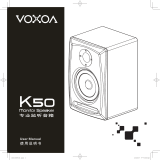
Battery safety instructions
Levenhuk International Lifetime Warranty
• Always purchase the correct size and grade of battery most suitable for the intended use.
• Always replace the whole set of batteries at one time; taking care not to mix old and new ones, or batteries
of dierent types.
• Clean the battery contacts and also those of the device prior to battery installation.
• Make sure the batteries are installed correctly with regard to polarity (+ and -).
• Remove batteries from equipment that is not to be used for an extended period of time.
• Remove used batteries promptly.
• Never attempt to recharge primary batteries as this may cause leakage, re, or explosion.
• Never short-circuit batteries as this may lead to high temperatures, leakage, or explosion.
• Never heat batteries in order to revive them.
• Remember to switch o devices aer use.
• Keep batteries out of the reach of children, to avoid risk of ingestion, suocation, or poisoning.
• Utilize used batteries as prescribed by your country laws.
All Levenhuk telescopes, microscopes, binoculars and other optical products, except for accessories, carry
a lifetime warranty against defects in materials and workmanship. Lifetime warranty is a guarantee on
the lifetime of the product on the market. All Levenhuk accessories are warranted to be free of defects in materials
and workmanship for six months from date of retail purchase. Levenhuk will repair or replace such product
or part thereof which, upon inspection by Levenhuk, is found to be defective in materials or workmanship.
As a condition to the obligation of Levenhuk to repair or replace such product, the product must be returned
to Levenhuk together with proof of purchase satisfactory to Levenhuk.
This warranty does not cover consumable parts, such as bulbs (electrical, LED, halogen, energy-saving
and other types of lamps), batteries (rechargeable and non-rechargeable), electrical consumables etc.
For further details, please visit our web site: https://www.levenhuk.com/warranty. If warranty problems
arise, or if you need assistance in using your product, contact the local Levenhuk branch.
• Be careful during your observations, always replace the dust cover aer you are nished with observations
to protect the device from dust and stains.
• If you are not using your microscope for extended periods of time, store the objective lenses and eyepieces
separately from the microscope.
• Store the device in a dry, cool place away from hazardous acids and other chemicals, away from heaters, open
re and other sources of high temperatures.
• When using the microscope, try not to use it near ammable materials or substances (benzene, paper,
cardboard, plastic, etc.), as the base may heat up during use, and might become a re hazard.
• Always unplug the microscope from a power source before opening the base or changing the illumination
lamp. Regardless of the lamp type (halogen or incandescent), give it some time to cool down before trying
to change it, and always change it to a lamp of the same type.
• Always use the power supply with the proper voltage, i.e. indicated in the specications of your new microscope.
Plugging the instrument into a dierent power outlet may damage the electric circuitry of the microscope, burn
out the lamp, or even cause a short circuit.
• Seek medical advice immediately if a small part or a battery is swallowed.
6








